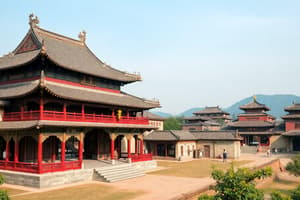Podcast
Questions and Answers
What is the earliest known human fossil found in China?
What is the earliest known human fossil found in China?
- Fuyan Cave fossils
- Yuanmou Man (correct)
- Homo erectus
- Xihoudu archaeological site fossils
Which dynasty was the first to have written records and known for oracle bones and bronzes?
Which dynasty was the first to have written records and known for oracle bones and bronzes?
- Shang dynasty (correct)
- Han dynasty
- Zhou dynasty
- Xia dynasty
Which period saw the rise of powerful principalities and the Hundred Schools of Thought?
Which period saw the rise of powerful principalities and the Hundred Schools of Thought?
- Eastern Zhou period
- Spring and Autumn period (correct)
- Warring States period
- Qin dynasty
Which dynasty standardized weights and measures, writing styles, and metal currency?
Which dynasty standardized weights and measures, writing styles, and metal currency?
Which dynasty was a golden age of Chinese civilization, with significant cultural, artistic, and technological developments?
Which dynasty was a golden age of Chinese civilization, with significant cultural, artistic, and technological developments?
Which dynasty was founded by the Manchus and enforced the queue order and bannermen system?
Which dynasty was founded by the Manchus and enforced the queue order and bannermen system?
Which rebellion controlled roughly a third of China proper for over a decade, but was ultimately crushed with a death toll of about 20 million?
Which rebellion controlled roughly a third of China proper for over a decade, but was ultimately crushed with a death toll of about 20 million?
Which dynasty saw the growth of private industry and the exploitation of south China's potential?
Which dynasty saw the growth of private industry and the exploitation of south China's potential?
Which dynasty extended territorial control to Central Asia and defeated the Russians at Albazin?
Which dynasty extended territorial control to Central Asia and defeated the Russians at Albazin?
Flashcards
Xia Dynasty
Xia Dynasty
The earliest of the Three Dynasties in ancient Chinese records.
Shang Dynasty
Shang Dynasty
The first Chinese dynasty with written records, known for oracle bones and bronzes.
Zhou Dynasty
Zhou Dynasty
The longest-lasting dynasty in Chinese history, which invoked the Mandate of Heaven.
Spring and Autumn Period
Spring and Autumn Period
Signup and view all the flashcards
Qin Shi Huang
Qin Shi Huang
Signup and view all the flashcards
Han Dynasty
Han Dynasty
Signup and view all the flashcards
Sui Dynasty
Sui Dynasty
Signup and view all the flashcards
Tang Dynasty
Tang Dynasty
Signup and view all the flashcards
Qing Dynasty
Qing Dynasty
Signup and view all the flashcards
Study Notes
Account of Chinese Civilization
Prehistory
- Homo erectus arrived in China between 1.3 and 1.8 million years ago.
- The oldest known human fossil in China is that of the Yuanmou Man, dated to c. 1.7 million years ago.
- Evidence of fire use by Homo erectus was found at the Xihoudu archaeological site in Shanxi Province, dated between 1-1.8 million years BP.
- The earliest known modern human fossils in China date back to 120,000–80,000 BP, discovered in Fuyan Cave of Dao County, Hunan.
- The Neolithic age in China began around 10,000 years ago, with agriculture developing gradually.
- The earliest evidence of cultivated rice was found by the Yangtze River, carbon-dated to 8,000 years ago.
- The Jiahu site is one of the best-preserved early agricultural villages, dated between 7000 to 5800 BC.
Bronze Age
- Bronze artifacts were found at the Majiayao culture site, dated between 3100 and 2700 BC.
- The Sanxingdui culture, a previously unknown Bronze Age culture, was discovered in Sichuan province, dated between 2000 and 1200 BC.
- Ferrous metallurgy began to appear in the late 6th century in the Yangzi Valley.
Ancient China
- The Xia dynasty (c. 2070 – c. 1600 BC) is the earliest of the Three Dynasties described in ancient historical records.
- The Shang dynasty (c.1600–1046 BC) was the first dynasty with written records and was known for oracle bones and bronzes.
- The Zhou dynasty (1046 BC to approximately 256 BC) was the longest-lasting dynasty in Chinese history and invoked the concept of the Mandate of Heaven to legitimize their rule.
- The Spring and Autumn period (722-481 BC) saw rival kingdoms developing bureaucratic systems that enabled them to control vast territories directly, laying the foundation for the imperial system of government.
Imperial China
-
Qin Shi Huang conquered the various warring states and created for himself the title of Huangdi or 'emperor' of the Qin, marking the beginning of imperial China.
-
The Han dynasty (206 BC – 220 AD) followed the short-lived Qin dynasty and was known for its centralized bureaucracy and expanding borders.
-
During the Three Kingdoms, the Jin and the Southern and Northern Dynasties, China was in a split state.
-
During the Sui, Tang and Five Dynasties, the economy flourished, science and technology developed, and cultural influence was extensive.
-
China's last dynasty was the Qing (1636–1912), which was replaced by the Republic of China in 1912, and then in the mainland by the People's Republic of China in 1949.Overview of Ancient China
-
The Eastern Zhou period began in 771 BC after the defeat of King You and his forces, and was divided into the Spring and Autumn and Warring States periods marked by warfare between states and the rise of powerful principalities.
-
The Hundred Schools of Thought of classical Chinese philosophy began during this period, including influential movements such as Confucianism and Taoism.
-
The Warring States period began in 476 BC, during which the seven prominent states battled each other and the Qin state became dominant, eventually unifying the other six regional powers and establishing the Qin dynasty in 221 BC.
-
The Qin dynasty was a centralized bureaucratic monarchy with a governing scheme that dominated the future of Imperial China, and was led by Emperor Qin Shi Huang who standardized weights and measures, writing styles, and metal currency.
-
The Han dynasty was founded in 206 BC by Liu Bang and was a golden age in Chinese history that consolidated the foundation of China as a unified state under a central imperial bureaucracy, which lasted intermittently for most of the next two millennia.
-
The Eastern Han dynasty was characterized by a gradual decentralization of the state and an increase in the power of great families, and was followed by the Sixteen Kingdoms period in which northern China fragmented into a series of independent states.
-
The Northern and Southern dynasties period began in the early 5th century, in which parallel regimes ruled the northern and southern halves of the country, and Buddhism spread throughout the land.Overview of Chinese Dynasties
-
The Sui dynasty unified China in 589, pioneered new institutions, and constructed the Grand Canal and expanded the Great Wall.
-
The Tang dynasty (618-907) was a golden age of Chinese civilization, with significant cultural, artistic, and technological developments, including the imperial examination system and the equal-field system.
-
The Five Dynasties and Ten Kingdoms period (907-960) was a time of political disunity and regional warlords.
-
The Song dynasty (960-1279) reunified most of China and was considered a high point of classical Chinese civilization, with advances in science, technology, and culture.
-
The Yuan dynasty (1271-1368) was a Mongol conquest dynasty that ruled the entire China proper and inherited the largest share of territory of the divided Mongol Empire, with the capital in Khanbaliq (modern-day Beijing).
-
The dynasties were marked by significant developments, including the government system of Three Departments and Six Ministries, the imperial examination system, the equal-field system, the Grand Canal, and technological innovations such as gunpowder and movable-type printing.Imperial China: A Brief History
-
The Mongols conquered China and established the Yuan dynasty, which saw the rise of paper currency, flourishing maritime trade, and cultural exchange, but also suffered hyperinflation and demographic decline.
-
The Ming dynasty was founded by Zhu Yuanzhang and emphasized agriculture, urbanization, and a strong central government. Foreign trade and exploration also increased during this time.
-
The Qing dynasty was the last imperial dynasty in China and was founded by the Manchus, who enforced the queue order and bannermen system, and consolidated all areas previously under the Ming dynasty.
-
The Qing dynasty was at its zenith during Qianlong Emperor's reign, but was later threatened by western powers and suffered internal rebellions, including the Taiping Rebellion and the Punti-Hakka Clan Wars.
-
The Taiping Rebellion was led by the "Heavenly King" Hong Xiuquan and controlled roughly a third of China proper for over a decade, but was ultimately crushed by Zeng Guofan's local armies with a death toll of about 20 million.
-
The dynasty never rebuilt a strong central army, and many local officials used their military power to effectively rule independently in their provinces.
-
The First Opium War led to the Treaty of Nanking, which allowed importation of opium and ceded Hong Kong to Britain, and subsequent military defeats and unequal treaties with other western powers continued even after the fall of the Qing dynasty.
-
The Ming dynasty intervened deeply in the Japanese invasions of Korea (1592-98), which preserved the regional hegemony of the Ming dynasty at a toll on its resources, and coincidentally weakened its suppression of internal peasants uprisings.
-
The Yuan dynasty saw the flow of people, trade, and cultural exchange facilitated by a network of roads and a postal system, and the Ming dynasty saw the growth of private industry and the exploitation of south China's potential.
-
The Qing dynasty extended territorial control to Central Asia and defeated the Russians at Albazin, and ruled more than one-third of the world's population and had the largest economy in the world by the end of Qianlong Emperor's long reign in 1796.
-
The Ming dynasty was characterized by a large group of foreign migrants who settled in China and enriched Chinese culture with foreign elements, while the Qing dynasty was characterized by internal restiveness and external threats from western powers.
Studying That Suits You
Use AI to generate personalized quizzes and flashcards to suit your learning preferences.




